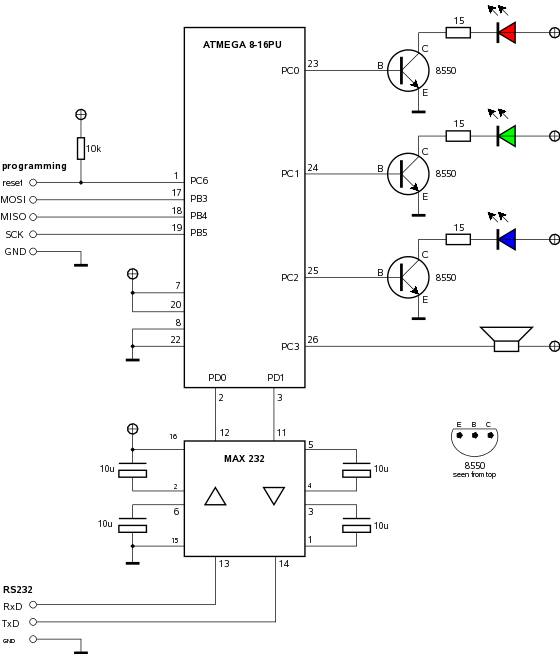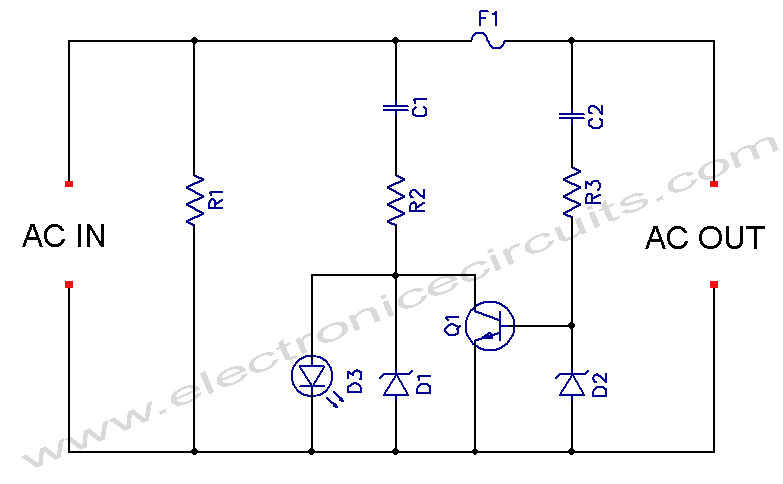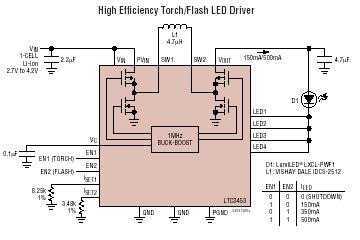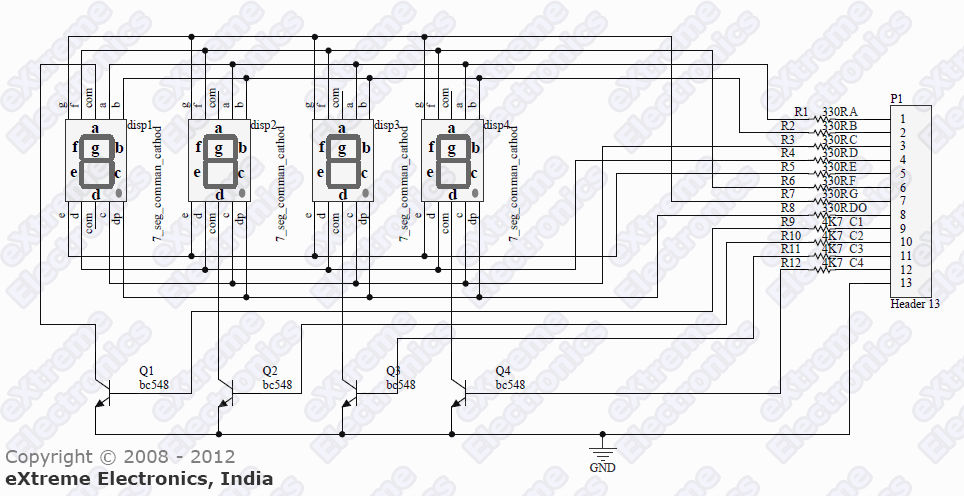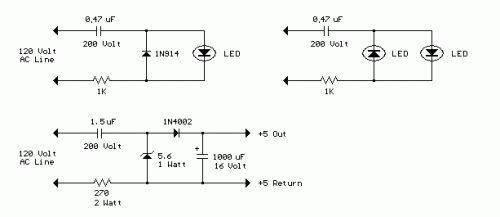
8x8 dotmatrix scrolling led display
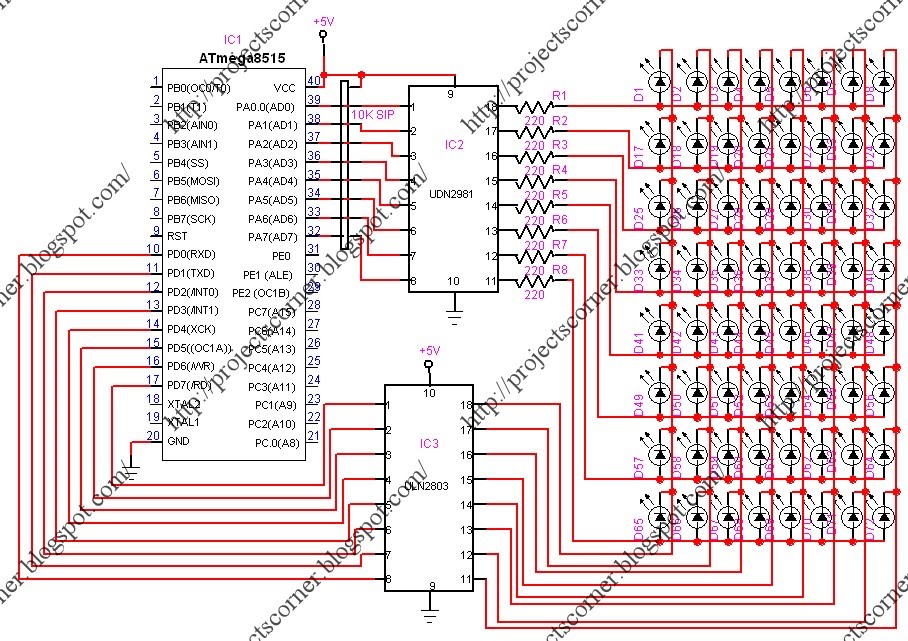
This project involves a scrolling LED display composed of 64 LEDs arranged in a matrix configuration. The anodes of the LEDs are driven by a driver IC, UDN2981, while the cathodes are controlled using the ULN2803. An Atmega8515 microcontroller is utilized to manage the display, and the programming is done using Bascom AVR. For instance, in column 1, the LEDs that are illuminated are 2, 3, 4, and 5, which corresponds to the binary value 00111100. The ninth byte serves as a blank column to separate the two images displayed.
The scrolling LED display project employs a matrix of 64 LEDs, organized in an 8x8 grid. This configuration allows for versatile visual output, enabling the display of various patterns and animations. The UDN2981 driver IC is responsible for managing the anode connections of the LEDs, providing the necessary current and voltage to light up the selected LEDs. Simultaneously, the ULN2803 serves as a sink for the cathodes, facilitating the control of the LED states by grounding the appropriate cathode connections.
The Atmega8515 microcontroller functions as the central processing unit for this project. It processes the data and controls the timing and sequencing of the LED illumination. The microcontroller is programmed using Bascom AVR, a high-level programming language tailored for AVR microcontrollers, which simplifies the coding process.
In terms of data representation, each column of the matrix corresponds to a byte of binary data. For example, in the first column, if LEDs 2, 3, 4, and 5 are illuminated, this is represented by the binary value 00111100. The design includes an additional ninth byte, which is set to zero, serving as a blank column. This blank column is crucial for visually separating different images or animations displayed on the scrolling LED matrix, enhancing readability and aesthetic appeal.
This project exemplifies the integration of microcontroller technology with LED display systems, showcasing how digital control can create dynamic visual effects. The choice of components, such as the UDN2981 and ULN2803, ensures reliable operation, while the Atmega8515 microcontroller provides flexibility in programming and functionality. Overall, this scrolling LED display project is a practical application of electronics that can be further expanded with additional features or enhanced programming techniques.Here`s an another project, which makes an Scrolling LED display. Here 64 leds which are connected to an Matrix display. The Anodes are drived through an Driver IC UDN2981 and the cathodes are drived through ULN2803. The Atmega8515 is used in this project to control the display. The microcontroller is programmed with Bascom AVR. For example, look the below image. At column 1 the leds to be glown are the 2. 3, 4, 5. So the equivalent value is 00111100 in binary. The last ninth byte is for a blank column. It is used to separate the 2 images on the display. 🔗 External reference
The scrolling LED display project employs a matrix of 64 LEDs, organized in an 8x8 grid. This configuration allows for versatile visual output, enabling the display of various patterns and animations. The UDN2981 driver IC is responsible for managing the anode connections of the LEDs, providing the necessary current and voltage to light up the selected LEDs. Simultaneously, the ULN2803 serves as a sink for the cathodes, facilitating the control of the LED states by grounding the appropriate cathode connections.
The Atmega8515 microcontroller functions as the central processing unit for this project. It processes the data and controls the timing and sequencing of the LED illumination. The microcontroller is programmed using Bascom AVR, a high-level programming language tailored for AVR microcontrollers, which simplifies the coding process.
In terms of data representation, each column of the matrix corresponds to a byte of binary data. For example, in the first column, if LEDs 2, 3, 4, and 5 are illuminated, this is represented by the binary value 00111100. The design includes an additional ninth byte, which is set to zero, serving as a blank column. This blank column is crucial for visually separating different images or animations displayed on the scrolling LED matrix, enhancing readability and aesthetic appeal.
This project exemplifies the integration of microcontroller technology with LED display systems, showcasing how digital control can create dynamic visual effects. The choice of components, such as the UDN2981 and ULN2803, ensures reliable operation, while the Atmega8515 microcontroller provides flexibility in programming and functionality. Overall, this scrolling LED display project is a practical application of electronics that can be further expanded with additional features or enhanced programming techniques.Here`s an another project, which makes an Scrolling LED display. Here 64 leds which are connected to an Matrix display. The Anodes are drived through an Driver IC UDN2981 and the cathodes are drived through ULN2803. The Atmega8515 is used in this project to control the display. The microcontroller is programmed with Bascom AVR. For example, look the below image. At column 1 the leds to be glown are the 2. 3, 4, 5. So the equivalent value is 00111100 in binary. The last ninth byte is for a blank column. It is used to separate the 2 images on the display. 🔗 External reference
